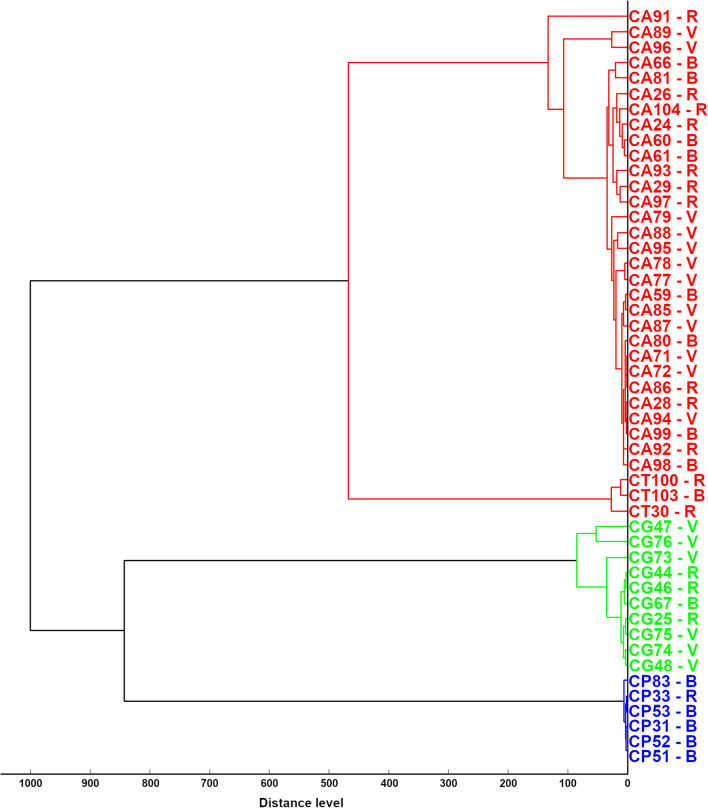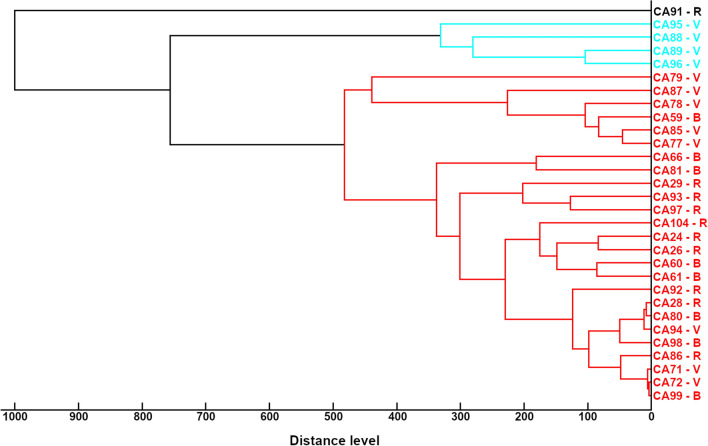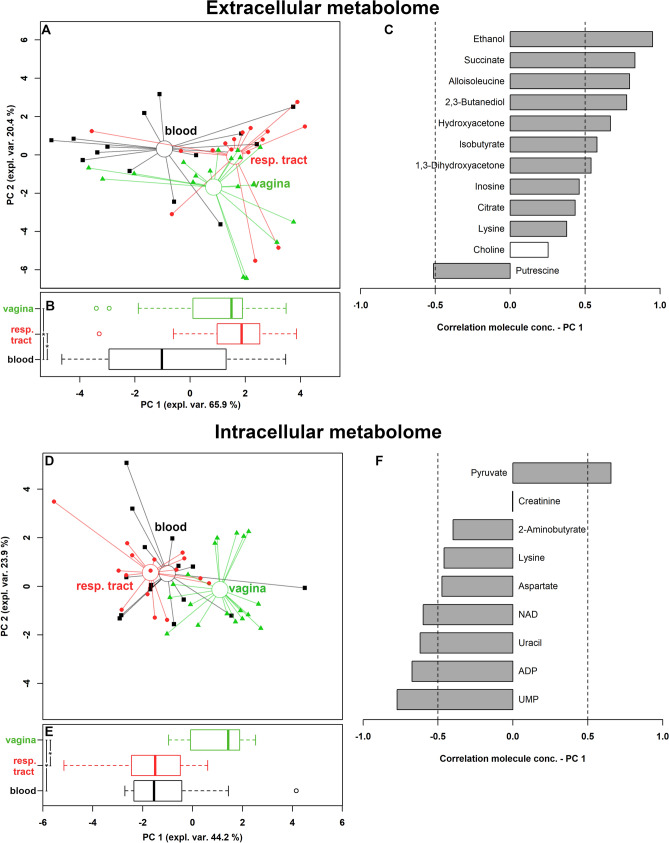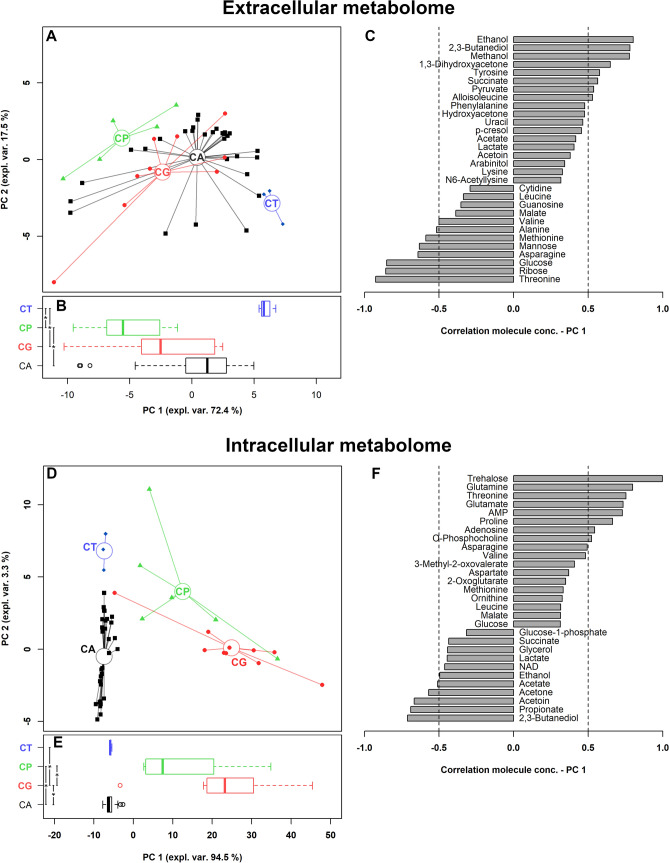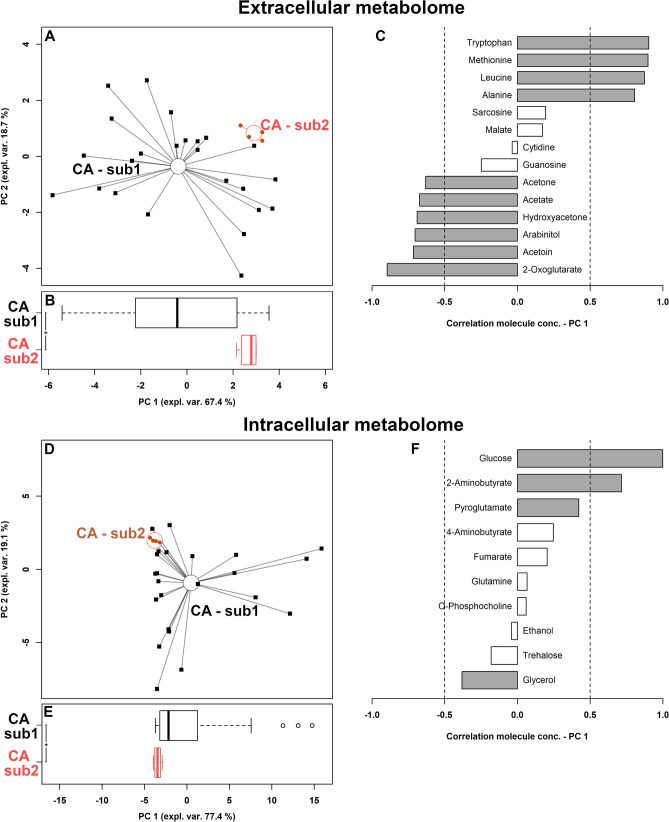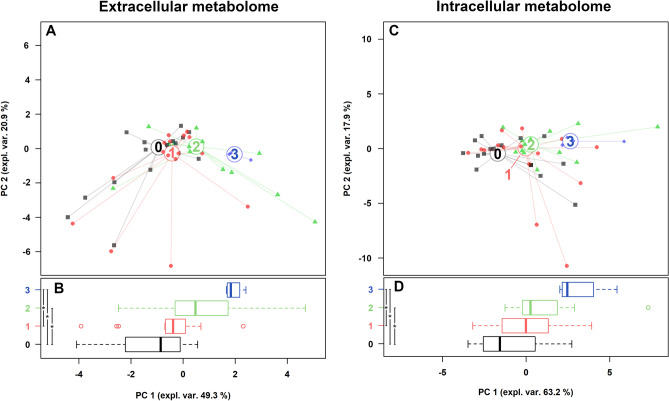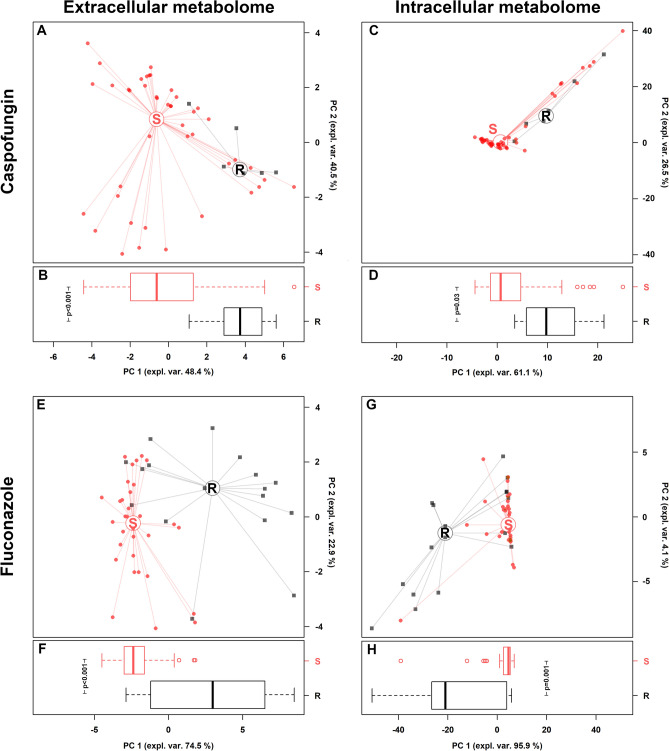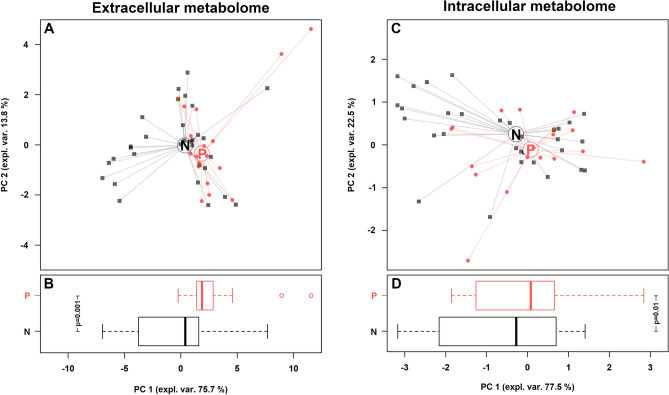Abstract
Candida species are the most common cause of opportunistic fungal infections. Rapid identification and novel approaches for the characterization of these fungi are of great interest to improve the diagnosis and the knowledge about their pathogenic properties. This study aimed to characterize clinical isolates of Candida spp. by proteomics (MALDI-TOF MS) and metabolomics (1H-NMR), and to correlate their metabolic profiles with Candida species, source of infection and different virulence associated parameters. In particular, 49 Candida strains from different sources (blood, n = 15; vagina, n = 18; respiratory tract, n = 16), belonging mainly to C. albicans complex (61%), C. glabrata (20%) and C. parapsilosis (12%) species were used. Several extracellular and intracellular metabolites showed significantly different concentrations among isolates recovered from different sources of infection, as well as among different Candida species. These metabolites were mainly related to the glycolysis or gluconeogenesis, tricarboxylic acid cycle, nucleic acid synthesis and amino acid and lipid metabolism. Moreover, we found specific metabolic fingerprints associated with the ability to form biofilm, the antifungal resistance (i.e. caspofungin and fluconazole) and the production of secreted aspartyl proteinase. In conclusion, 1H-NMR-based metabolomics can be useful to deepen Candida spp. virulence and pathogenicity properties.
Subject terms: Biological techniques, Biotechnology, Microbiology, Pathogenesis
Introduction
Candida species are the most common cause of opportunistic fungal infections mainly in immunocompromised individuals1. Candida spp. are able to cause mucocutaneous lesions, such as oropharyngeal or vaginal candidiasis, and systemically invasive infections that are associated with high mortality2–4. Candida albicans is still the most commonly isolated species, but other non-albicans Candida species have been isolated from patients and drawn attention because of their resistance to antifungals5–7.
Different Candida species may have very different antifungal susceptibility profiles. In this context, it is important to obtain accurate taxonomic identification to apply appropriate treatments8,9. Traditionally, fungi are identified by phenotypic traits including morphology, colony appearance and pigmentation in chromogenic culture medium8,10,11. Recently, alternative methods for rapid identification of microorganisms have been studied, such as proteomics, using matrix-assisted laser desorption/ionization time-of-flight mass spectrometry (MALDI-TOF MS), and metabolomics by nuclear magnetic resonance (NMR)8,12–15. MALDI-TOF MS has short analysis time, low error rate and high precision for microorganism identification because it can discriminate between closely related and critical species, making it suitable for implementation in the field of clinical routine12,16,17. NMR spectroscopy generates complex data based on metabolic profiles, which can be used not only for metabolites’ mere quantification, but also for accurate identification of yeast to subspecies level18,19. In addition, metabolic profiles have the potential to be used as antifungal resistance markers20. These methods are widely used in the search for factors associated with virulence of microorganisms, besides, they can help in the differential diagnosis of clinical isolates of Candida spp. for appropriate treatments. In this perspective, the present study aims to characterize clinical isolates of Candida spp. by proteomic and metabolomic methodologies, and to correlate their metabolic profiles with Candida species, infection source and important virulence factors, such as the ability to form biofilm, antifungal resistance and production of secreted aspartyl proteinase (SAP).
Results
Candida species distribution and hierarchic dendrograms
Forty-nine Candida clinical isolates, recovered from different sources of infection (30.6% blood, 36.7% vaginal tract and 32.7% respiratory tract) during routine diagnostic procedures, were identified by proteomic characterization using MALDI-TOF MS. The distribution of Candida species (59.2% C. albicans, 20.4% C. glabrata, 12.2% C. parapsilosis, 6.2% C. tropicalis, 2% C. dubliniensis; Supplementary Table S1) reflects the one found in clinical practice, as reported by Cataldi et al.21.
Figure 1 shows the hierarchic dendrogram of the MSPs obtained from the 49 Candida strains. As expected, MSP dendrogram clustered the Candida strains according to their species and identified two main groups: the first one comprised C. albicans complex (29 C. albicans and one C. dubliniensis) and C. tropicalis; the second one C. glabrata and C. parapsilosis. Figure 2 shows the hierarchical dendrogram of the C. albicans complex, comprising 30 strains. At the distance of 1000 arbitrary units (maximum dissimilarity) C. dubliniensis 91 appeared as separated from all the other C. albicans strains, while at the distance of 760 arbitrary units it is possible to recognize two sub-groups comprising 4 and 25 C. albicans strains, respectively.
Figure 1.
Cluster analysis of main spectrum profiles obtained by MALDI-TOF MS from Candida strains included in the study. In the dendrogram, relative distance between isolates is displayed as arbitrary units. Zero indicates complete similarity and 1000 indicates maximum dissimilarity. CA, C. albicans complex (one C. dubliniensis -CA91- and 29 C. albicans); CT, C. tropicalis; CG, C. glabrata; CP, C. parapsilosis, numbers identified strains. V isolated from vaginal tract, B blood origin, R isolated from respiratory tract.
Figure 2.
Cluster analysis of main spectrum profiles obtained by MALDI-TOF MS from Candida albicans strains included in the study. In the dendrogram, relative distance between isolates is displayed as arbitrary units. Zero indicates complete similarity and 1000 indicates maximum dissimilarity. CA, C. albicans complex, numbers identified strains. V isolated from vaginal tract, B blood origin, R isolated from respiratory tract.
Candida species identification obtained by MALDI-TOF MS was always confirmed by Internal Transcribed Spacer (ITS) sequencing (Supplementary Table S1).
Differential metabolome profiles associated with the isolation source
Candida strains were subjected to metabolomic analysis by 1H-NMR. Both Candida culture supernatants and cell lysates were examined, in order to depict extracellular and intracellular metabolome profiles, respectively. Metabolome analysis allowed the identification and quantification of 48 molecules in the extracellular metabolome and 47 molecules in the intracellular metabolome, with 29 molecules in common.
We evaluated whether Candida clinical isolates recovered from different sources of infection showed differences in their metabolome profiles. Twelve extracellular metabolites and 9 intracellular metabolites showed different concentrations when compared among isolates form blood, respiratory tract, and vagina (Supplementary Tables S2–S3). None of them could be quantified both in the extracellular and intracellular environments.
Two robust principal component analysis (rPCA) models were built to identify the overall trends underlying these molecules (Fig. 3). The data were optimally summarized by 3 and 4 principal component (PC), respectively. For both extracellular and intracellular metabolome, the first PC (PC 1) of the scoreplot offered a clear summary of the peculiarities of the strains from the different infection sources (Fig. 3A,D). Along this direction, samples collected from vagina and blood were characterized by statistically different PC 1 scores (Fig. 3B,E). The samples collected from the respiratory tract appeared similar to those collected from the vagina when the extracellular metabolome was observed, while they appeared similar to those collected from the blood when the intracellular metabolome was observed.
Figure 3.
Correlation between extracellular and intracellular metabolome and Candida
source of infection. (A,D) Scoreplots of the rPCA models calculated on the spaces constituted by the concentration of the molecules significantly different among Candida strains grouped on the basis of their source of infection (respiratory tract, vagina, blood). Empty circles highlight the median values of the samples from the different sources. (B,E) Box plots summarizing the positions of the samples along PC 1. (C,F) Bar plots describing the correlation between the concentration of each molecule and its importance along PC 1. *P < 0.05.
Figure 3C allows to visually appreciate that the molecules of the extracellular metabolome mostly contributing to the distribution of the samples along PC 1 are ethanol, succinate, alloisoleucine, 2,3-butanediol and hydroxyacetone. These molecules are produced by all the strains, particularly by those collected from the vaginal environment and the respiratory tract.
Figure 3F shows that the molecules detected in the intracellular metabolome that mostly contributed to the differentiation of the strains according to the collection site were UMP, ADP, uracil, NAD and pyruvate. UMP, ADP, uracil, NAD were more concentrated in Candida strains isolated from blood and respiratory tract, while pyruvate mainly characterized vaginal strains. All these molecules, together with aspartate, are involved in the metabolism of carbohydrates, whose over-representation appeared to be statistically significant (P = 0.035), as calculated by over representation analysis (ORA). A direct link between the molecules highlighted in extracellular and intracellular metabolome can be found by observing that 2,3-butanediol is produced by microorganisms from the anaerobic fermentation of pyruvate22.
Differential metabolome profiles associated with Candida species
We then evaluated whether Candida clinical isolates belonging to different complex/species showed differences in their metabolome profiles. Forty extracellular and 41 intracellular metabolites showed different concentrations when compared among the various complex/species (Supplementary Tables S4–S5). Twenty-one of them were in common between the two environments. The 40 and 41 molecules differing among Candida strains represented the 83% and 87% of all the molecules overall observed in the two environments. To grab the overall trends described by these molecules, two rPCA models were created, optimally described by 3 and 2 PCs, respectively (Fig. 4). In each case, PC 1 best described the peculiarities among the species, as it can be visually appreciated from the scoreplots in Fig. 4A,D. As it can be seen from the boxplots (Fig. 4B,E), in both cases C. tropicalis strains never showed statistically different PC 1 scores from C. albicans complex ones, in accordance with the dendrogram based on MALDI-TOF MS measurements (Fig. 1). Considering the extracellular metabolome profile, C. albicans complex and C. tropicalis strains, along with C. glabrata, were mainly characterized by higher concentrations of ethanol, 2,3-butanediol, tyrosine and succinate, and a more marked consumption of methanol, ribose, glucose and methionine, with respect to C. parapsilosis isolates (Fig. 4C). When the intracellular metabolome was considered (Fig. 4F), differences strictly mimicking those highlighted by MALDI-TOF MS could be observed, being C. albicans complex strains' PC 1 values similar to those of C. tropicalis group, and significantly different from C. parapsilosis and C. glabrata ones. In addition, C. parapsilosis and C. glabrata differed one from the other. Looking at intracellular metabolites, C. albicans complex and C. tropicalis strains showed high levels of 2,3-butanediol, propionate, acetoin and acetone; on the other side, C. glabrata isolates contained high concentrations of trehalose and the amino acids glutamine, threonine, glutamate and proline. The abundance of molecules with a concentration differing among the groups both in extracellular and intracellular metabolome did not allow to identify by ORA analysis a specific metabolic pathway mostly responsible for the sample’s distribution.
Figure 4.
Correlation between extracellular and intracellular metabolome and Candida species. (A,D) Scoreplots of the rPCA models calculated on the spaces constituted by the concentration of the molecules significantly different among species. Empty circles highlight the median of the species. (B,E) Box plots summarizing the positions of the samples along PC 1. (C,F) Bar plots describing the correlation between the concentration of each molecule and its importance along PC 1. CA C. albicans complex, CT C. tropicalis, CG C. glabrata, CP C. parapsilosis. *P < 0.05.
Differential metabolites associated with Candida albicans sub-groups
To observe if the two C. albicans sub-groups visually identified by MALDI-TOF-based clustering corresponded to actual metabolomic differences, a univariate analysis was set up on a molecule-by-molecule basis. Fourteen molecules in the extracellular metabolome and 10 in the intracellular indeed differentiated the two sub-groups (Supplementary Tables S6–S7). The corresponding summarizing rPCA models were best described by 4 and 3 PCs, respectively (Fig. 5A,D). In both cases PC 1 optimally grabbed the differences between the sub-groups, so that their PC 1 scores appeared as statistically different (Fig. 5B,E). The discrepancies between the extracellular metabolome features of the two sub-groups revolved mainly around amino acids metabolism, with tryptophan, methionine, leucine and alanine mostly differentiating the two groups, together with 2-oxoglutarate (Fig. 5C). The intracellular molecule mostly contributing to the differentiation was glucose (Fig. 5F).
Figure 5.
Correlation between extracellular and intracellular metabolome and C. albicans sub-groups. (A,D) rPCA models calculated on the spaces constituted by the concentration of the molecules significantly different between sub-groups. Empty circles highlight the median of the subgroup. (B,E) Box plots summarizing the positions of the samples along PC 1. (C,F) bar plots describing the correlation between the concentration of each molecule and its importance along PC 1. CA C. albicans. *P < 0.05.
Correlation between metabolome and virulence factors
We further investigated the correlations between the extracellular and intracellular metabolites and some important virulence-associated parameters for Candida pathogenesis, i.e. the ability to form biofilm, the resistance to different antifungal agents (caspofungin, fluconazole and amphotericin-B) and the production of SAP.
Firstly, we evaluated the capability of all Candida strains to form biofilm on an abiotic surface. In relation to this feature, we classified the strains into 4 categories, named 0 (no biofilm; n = 16), 1 (weak producers; n = 16), 2 (intermediate producers; n = 13), 3 (strong producers; n = 4) (Supplementary Table S1), and we searched for correlations with metabolites by means of the same methodological approach described in the previous paragraphs. Five extracellular and 9 intracellular metabolites showed significant different concentrations when compared among biofilm categories (Supplementary Tables S8–S9). Interestingly, the strongest biofilm producers were characterized by the highest concentrations of glutamate and lysine in the intracellular compartment.
rPCA models were able to separate Candida isolates on PC 1, as shown in Fig. 6A,C. Indeed, as pointed out in the boxplots (Fig. 6B,D), non-producing Candida strains (group 0) were statistically different from intermediate and strong biofilm producing strains (groups 2 and 3). Group 3 was also statistically differentiated from weak biofilm producers (group 1), for both extracellular and intracellular metabolome.
Figure 6.
Correlation between extracellular and intracellular metabolome and the ability to form biofilm. (A,C) rPCA models calculated on the spaces constituted by the concentration of the molecules significantly different among Candida strains grouped on the basis of their ability to form biofilm (0: no biofilm; 1: weak producers; 2: intermediate producers; 3: strong producers). (B,D) Box plots summarizing the positions of the samples along PC 1. *P < 0.05.
When analyzing the susceptibility to antifungal drugs (Supplementary Table S1), we found that all strains were susceptible to amphotericin-B with MIC values ranging between ≤ 0.007 and 0.125 µg/mL. A total of 17 strains (4 C. albicans, 1 C. parapsilosis, 2 C. tropicalis, and all 10 C. glabrata strains) were resistant to fluconazole, whereas 6 to caspofungin (1 C. dubliniensis and 5 C. parapsilosis). Interestingly, all C. albicans fluconazole-resistant strains were SAP producers (Supplementary Table S1), as previously reported23.
Twenty-two extracellular and 24 intracellular metabolites showed significant different concentrations between fluconazole-resistant and susceptible strains (Supplementary Tables S10–S11), as well as 19 extracellular and 16 intracellular molecules were significantly different based on caspofungin susceptibility (Supplementary Tables S12–S13).
It is worth of note that both fluconazole and caspofungin-resistant strains showed higher threalose concentrations in the intracellular compartment, compared to susceptible isolates.
rPCA models were able to separate Candida isolates on PC 1, as shown in Fig. 7A,C,E,G. Indeed, as pointed out in the boxplots (Fig. 7B,D,F,H), susceptible Candida strains (S) were statistically different from resistant ones (R), for both extracellular and intracellular metabolome.
Figure 7.
Correlation between extracellular and intracellular metabolome and Candida susceptibility to caspofungin and fluconazole. (A,C,E,G) rPCA models calculated on the spaces constituted by the concentration of the molecules significantly different between susceptible (S) and resistant (R) Candida strains. (B,D,F,H) Box plots summarizing the positions of the samples along PC 1. *P < 0.05.
Finally, Candida strains were categorized based on SAP activity (Supplementary Table S1): 31 strains were not-producers, whereas 18 showed SAP activity (visible clear zone from 1 to 12 mm). Interestingly, the strongest SAP producers were two C. albicans strains isolated from respiratory tract.
Ten extracellular and 3 intracellular metabolites showed significant different concentrations between SAP-producers and non-producers (Supplementary Tables S14–S15). rPCA models were able to separate Candida isolates on PC 1, as shown in Fig. 8A,C. Indeed, as pointed out in the boxplots (Fig. 8B,D) SAP-producers (P) were statistically different from non-producers (N), for both extracellular and intracellular metabolome.
Figure 8.
Correlation between extracellular and intracellular metabolome and SAP production. (A,C) rPCA models calculated on the spaces constituted by the concentration of the molecules significantly different between SAP producers (P) and non-producers (N). (B,D) Box plots summarizing the positions of the samples along PC 1. *P < 0.05.
Discussion
In recent years, methods for the rapid identification of microorganisms have been developed, which have enabled the detection of new species and characterization of their components and/or metabolites. These methods have been based on proteomic profiles, using MALDI-TOF MS, and metabolome profiles, by 1H-NMR and hyphenated mass spectrometry8,12–15.
Candida albicans is the most common cause of candidiasis, followed by C. glabrata and C. parapsilosis9,24–26. Invasive infections by these fungi have a high morbidity and mortality rate, so rapid identification and novel approaches for their characterization are of great interest to improve the diagnosis and the knowledge about their virulence and pathogenic properties.
Protein identification by MALDI-TOF MS may provide data for comparing Candida spp. virulence factors, such as phospholipases or aspartyl proteases27,28.
Metabolomic analysis by 1H-NMR is an intrinsically quantitative platform and therefore is extremely simple and quick29. In our work, this technique allowed to identify and quantify 66 metabolites produced by different Candida species, recovered from different sites of infection. These metabolites are associated with glycolysis or gluconeogenesis, tricarboxylic acid (TCA) cycle, nucleic acids synthesis and amino acids and lipids metabolism. These metabolic pathways are mainly related to energy production and also to virulence mechanisms20,30–33.
Candida clinical isolates recovered from blood, respiratory tract and vaginal environment showed differences in their metabolome profiles. The metabolites ethanol, 2,3-butanediol, hydroxyacetone, isobutyrate and 1,3-dihydroxyacetone showed different concentrations in the extracellular metabolome, when compared among isolates from different sources. These molecules are products of the glucose metabolism by Candida spp.22,34. Candida isolates from the respiratory tract showed high concentrations of ethanol in the extracellular metabolome. Candida spp. are relatively intolerant to ethanol and therefore secrete ethanol into the extracellular medium34. However, ethanol can be used as an alternative carbon source in the absence of glucose, which is converted into the central metabolite acetyl-CoA and used to produce glucose and energy35,36.
Further considering the extracellular metabolome, succinate and, to a lesser extent, citrate showed different concentrations among the groups analyzed. These molecules are also related to energy production, being involved in the tricarboxylic acid cycle30.
Nine Candida intracellular metabolites were significantly different in relation to the source of infection. These molecules are mainly involved in the metabolism of glucose (i.e. pyruvate, ADP, NAD, 2-aminobutyrate), amino acids (i.e. aspartate, lysine, creatinine) and nucleic acids (i.e. uracil and UMP)20,32,37. Blood Candida isolates showed higher concentrations of aminobutyrate than the others. Aminobutyrate is related to the gamma-aminobutyric acid (GABA) and it can be also used for succinate synthesis38. These metabolites can also be related to the virulence because GABA increases in vitro germ-tube formation and phospholipase B1 expression in C. albicans39.
Candida isolates from the respiratory tract showed higher concentrations of UMP and uracil. There may be subtle relationships between uridine uptake, cell adhesion, growth rate, the amount or composition of mannoproteins or other components of C. albicans cell wall40. UMP and uracil could be related to Candida virulence, as they are important for the pathogenicity of the opportunistic mould Aspergillus fumigatus41.
In this study, the highest concentrations of aspartate, lysine and creatinine were observed in respiratory tract, blood and vagina isolates, respectively. Aspartate is an amino acid associated with virulence and stress due to the exposure to antifungals20.
In addition, SAP are globular proteins with two aspartate catalytic sites, which are involved in the adhesion, tissue invasion and in the degradation of structural proteins of the host's immune system42–44. In our in vitro studies, the strongest SAP producers were strains isolated from the respiratory tract with no significant relation between SAP activity and higher concentrations of aspartate in the metabolome.
Another amino acid related to virulence and stress response is lysine: C. albicans increases lysine levels after exposure to ketoconazole20. Lysine acetylation is a prevalent modification in enzymes that catalyze intermediate metabolism and C. glabrata increases cellular lysine deacetylase activity in response to the intracellular milieu of macrophage45,46.
In relation to the taxonomy, 40 extracellular and 41 intracellular metabolites showed different concentrations when compared among Candida species. Differences strictly mimicking those highlighted by MALDI-TOF MS could be observed mainly in the intracellular metabolome. C. albicans complex and C. tropicalis strains showed high levels of 2,3-butanediol, propionate, acetoin and acetone. These metabolites are microbial fermentation products and can also be related to fungal virulence47. On the other hand, C. glabrata isolates contained high concentrations of trehalose and the amino acids glutamine, threonine, glutamate, and proline. In addition to serve as an alternative carbon source, trehalose has a critical role in the morphogenesis and response to fungal stress, especially dehydration, thermal and oxidative stress48–50. Amino acids are not only cell signaling molecules but are also important in fungal virulence as regulators of gene expression, morphogenesis and biofilm growth, key precursors for syntheses of hormones and low-molecular weight nitrogenous substances with enormous biological importance51,52. Previous studies also suggested the role of proline in reducing the production of reactive oxygen species in the mitochondria53.
Two C. albicans sub-groups were visually identified by MALDI-TOF-based clustering and showed metabolomic differences in the levels of intracellular glucose and extracellular amino acids (i.e. tryptophan, methionine, leucine, and alanine). These data, indeed, showed how the metabolomic analysis by 1H-NMR is effective at identifying Candida species and even subgroups. Over again, some amino acids contributed to the differentiation among the groups which are not only related to primary metabolism but also to fungal virulence51.
Moreover, we found specific metabolic fingerprints associated with different Candida virulence-associated features, such as the ability to form biofilm and the antifungal resistance.
In relation to biofilm formation, we confirmed the importance of amino acids in biofilm growth, as demonstrated by the higher concentrations of glutamate and lysine in the intracellular compartment of the strongest producer strains51.
Regarding the in vitro testing of antifungal drugs, we observed that both fluconazole and caspofungin-resistant strains showed higher threalose concentrations in the intracellular compartment. In this context, it has been shown that threalose biosynthesis pathway could be the target of new therapeutic drugs, opening new perspectives in the field of antifungal therapies49.
In conclusion, our data showed that Candida spp. produce different amounts of metabolites depending on the site of infection, the species and the virulence factors. Therefore, the metabolomic analyses can be used not only for identification of Candida species but also for pathogenicity studies.
Further studies, including a larger number of strains, are needed to better understand the metabolic pathways involved in pathogenic and biological-associated properties of Candida spp. Moreover additional experiments with more specialized media mimicking the different sources of infection, will shed light on the priming of fungal metabolism in the different ecological niches.
Methods
Strains and culture conditions
Forty-nine Candida strains were collected at the Bacteriology Laboratory, Sant’Orsola Malpighi University Hospital, Bologna, Italy, during the period October–November 2018 during routine diagnostic procedures. The 49 Candida strains were collected from respiratory tract, vaginal swabs, and blood, and were kept anonymous. Samples were seeded on Sabouraud dextrose agar (Vakutest Kima, Padova, Italy) and were grown aerobically at 37 °C. The identification at the species level was obtained by means of a matrix-assisted laser desorption/ionization time-of-flight mass spectrometry (MALDI-TOF MS), using Bruker instrument (Bruker Daltonics, Bremen, Germany)12.
MALDI-TOF MS sample preparation and analysis
Sample preparation for MALDI-TOF MS analysis was performed as previously described by Foschi et al.12. Cell pellets corresponding to 108 colony forming unit (CFU) (24-h cultures) were washed with 300 μL of sterile water and 900 μL of absolute ethanol, then suspended in 25 μL of 70% formic acid and 25 μL of pure acetonitrile. The solutions were thoroughly vortexed and centrifuged at 18,000×g for 10 min. Afterwards, 1 μL of the supernatants was spotted in six replicates on a ground-steel MALDI target plate (Bruker Daltonics), dried at room temperature and overlaid with 1 μL of MALDI HCCA matrix solution (10 mg/mL of α-ciano-4-hydroxycinnamic acid in 50% acetonitrile-2.5% trifluoroacetic acid; Bruker Daltonics). A MALDI-TOF MS measurement was performed using a Bruker instrument (Bruker Daltonics) operating in linear, positive ion mode and using the Flex Control 3.3 software with the following parameters: laser frequency: 20%; ion extraction delay time, 30 ns; ion source voltage one, 19 kV; ion source voltage two, 15.8 kV; and ion source lens voltage, 7.75 kV. A total of 240 laser shots was automatic acquired for each spectrum.
For species identification, spectra collected within a mass range of 2000–20,000 Da were analyzed with Bruker Biotyper 3.1 software and compared with the ones of the reference database.
A clustering analysis of all the Candida strains, belonging to different species, was performed by the generation of a score-oriented dendrogram. In particular, the MSPs of each strain were generated from at least 8 technical replicates (the ones with the highest score values at the species identification) using the MALDI Biotyper 3.1 software, with default setting parameters12. A peak quality control was performed using FlexAnalysis software 3.3 (Bruker Daltonics): spectra with outlier peaks or anomalies were removed from the spectra set of the Candida strain. The relationship between MSPs obtained from each strain was visualized in a score-oriented dendrogram using the average linkage algorithm implemented in the MALDI Biotyper 3.1 software. MSPs were created in relation to their mass signals and peak intensities.
ITS sequencing
To confirm Candida identification at the species level, ITS sequencing was performed as follows. Total DNA of Candida isolates was extracted by Versant sample preparation module (Siemens Healthcare Diagnostics, Tarrytown, NY, USA) and amplified using ITS1/4 primers54. Amplicons were sequenced, edited using BioEdit Sequence Alignment program and compared with reference ITS regions deposited in the GenBank Database.
Candida fractions preparation
Candida strains were grown in Sabouraud Dextrose Agar at 37 °C for 24 h. Candida suspensions were prepared in water to an optical density (OD 600 nm) of 0.1, corresponding to a cell concentration of 106 CFU/mL. Aliquots of 0.5 mL of Candida suspensions were added to 5 mL of Sabouraud Dextrose Broth and the tubes were incubated at 37ºC and 180 rpm for 24 h. The turbidity of the Candida cultures was adjusted to an optical density (OD 600 nm) of 0.8. Cell suspensions were centrifuged at 5000×g for 5 min at 4 °C, then supernatants were filtered through a 0.22 μm membrane filter to obtain cell free supernatants and analyzed by 1H-NMR to examine the extracellular metabolome. Cell pellets were washed in sterile water, re-suspended in 500 μL of lysis buffer (20 mM Tris HCl pH 8, 2 mM sodium EDTA, 1.2% Triton X-100) and then vortexed with 0.2 g of glass beads to ensure a complete lysis. Glass beads were then precipitated by centrifugation (4700×g for 5 min) and the supernatants, containing metabolites, were collected, and employed for 1H-NMR analysis of the intracellular metabolome, as described below.
Metabolomics investigation
Each cell free supernatant (700 µl) and lysate (500 µl) obtained from Candida cultures was added to 100 μL of a D2O solution of 3-(trimethylsilyl)-propionic-2,2,3,3-d4 acid sodium salt (TSP) 10 mM set to pH 7.0 by means of a 1 M phosphate buffer. An AVANCE III spectrometer (Bruker, Milan, Italy) was employed to register 1H-NMR spectra at 298 K and at a frequency of 600.13 MHz. Broad signals from slowly tumbling molecules were reduced with a T2 filter of 400 echoes, separated by an echo time of 400 µs. Signals assignment was performed by Chenomx (Chenomx Inc., Canada, ver 8.02). Spectra processing and molecules quantification was performed, by following Foschi et al.55, in R computational language56, while artwork was refined by GIMP (version 2.10, www.gimp.org). Prior to univariate analysis, data were transformed to normality by means of BoxCox transformation57. Differences between two groups were highlighted by t test, while differences among three or more groups were highlighted by ANOVA test followed by Tukey HSD test, by taking advantage of the corresponding functions implemented in the R package “agricolae”. For the above statistical tests, a cut-off P value of 0.05 was accepted. Metabolic pathway analysis was conducted though Reactome pathway knowledgebase58, with over representation analysis (ORA) based on hypergeometric test59.
Biofilm formation assay
Candida suspensions were prepared in sterile water from 24 h Sabouraud Dextrose Agar cultures, to an OD 600 nm of 0.8–1.2 (corresponding to 5 × 106–107 CFU/mL). Water suspensions were diluted 1:10 in SDB and inoculated in a sterile 96-well flat-bottomed plastic plate (200 μL/well) and allow to grow for 24 h at 37 °C under gentle shaking conditions (50 rpm). Afterwards, the medium was removed and the adherent biofilms were stained by crystal violet60. Briefly, biofilms were gently washed with PBS twice, then fixed with 200 μL of 99% ethanol for 15 min, before being stained for 2 min with 1% (w/V) crystal violet in 12% ethanol. Excess stain was rinsed out by washing the multi-well plate with water for three times. Subsequently, the plate was air dried, the dye bound to the adherent Candida cells was re-solubilized in 200 μL of 33% (V/V) ethanol and the absorbance was measured at 595 nm using a EnSpire Multimode Plate Reader (Perkin-Elmer). All assays were performed in quadruplicate.
Antifungal susceptibility testing
All Candida strains were tested for antifungal susceptibility by broth microdilution method, following EUCAST guidelines (version 7.3.2, available at: https://www.eucast.org/astoffungi/). In particular, caspofungin, fluconazole and amphotericin-B were tested and MIC values were interpreted by EUCAST clinical breakpoints.
SAP production assay
All Candida isolates were tested in vitro fot the ability to produce SAP. Briefly, SAP activity was assessed by a culture-based method, using a medium composed as follows: 1.17% yeast carbon base (Sigma Aldrich, Milan, Italy), 0.01%; yeast extract (Sigma Aldrich), 0.2% bovine serum albumin (Sigma Aldrich). The medium was adjusted to pH 5, sterilized by filtration, and added to the stock solution of autoclaved 2% agar. Plates were incubated for 7 days at 37° C in aerobic condition. Candida strains were classified in non-producers (when no visible clarification of the agar around the colony was present) or SAP producers (when visible clear zone ≥ 1 mm was detected).
Supplementary information
Acknowledgements
This study was financed in part by the ‘Coordenação de Aperfeiçoamento de Pessoal de Nível Superior-Brasil’ (CAPES)—Finance Code 001 (No. 88881.187121/2018-01) and ‘Ministero dell’Istruzione, Università e Ricerca’ (MIUR), Italy.
Author contributions
B.V., M.C., A.M., J.C.O., L.L., and A.L.T.D. conceived and supervised the study. A.L., C.F., M.C., L.L., J.C.O., and C.P. performed the experiments and the statistical analysis. C.F. and M.C. collected samples. J.C.O., L.L., B.V., C.P., A.M., C.F., and M.C. wrote the manuscript. All authors read, reviewed, and approved the final manuscript.
Data availability
Raw metabolomic data were deposited in the Metabolights repository (https://www.ebi.ac.uk/metabolights/), under the accession number MTBLS1978. ITS sequences of all Candida strains were deposited in GenBank under the accession numbers (MT876136-84) (Supplementary Table S1).
Competing interests
The authors declare no competing interests.
Footnotes
Publisher's note
Springer Nature remains neutral with regard to jurisdictional claims in published maps and institutional affiliations.
These authors contributed equally: Josidel Conceição Oliver and Luca Laghi.
Supplementary information
is available for this paper at 10.1038/s41598-020-73889-1.
References
- 1.Sardi JCO, Scorzoni L, Bernardi T, Fusco-Almeida AM, Mendes Giannini MJS. Candida species: Current epidemiology, pathogenicity, biofilm formation, natural antifungal products and new therapeutic options. J. Med. Microbiol. 2013;62:10–24. doi: 10.1099/jmm.0.045054-0. [DOI] [PubMed] [Google Scholar]
- 2.Corzo-Leon DE, et al. Surveillance of Candida spp. bloodstream infections: Epidemiological trends and risk factors of death in two Mexican tertiary care hospitals. PLoS One. 2014;9:e97325. doi: 10.1371/journal.pone.0097325. [DOI] [PMC free article] [PubMed] [Google Scholar]
- 3.Farhan MA, Moharram AM, Salah T, Shaaban OM. Types of yeasts that cause vulvovaginal candidiasis in chronic users of corticosteroids. Med. Mycol. 2018 doi: 10.1093/mmy/myy117. [DOI] [PubMed] [Google Scholar]
- 4.de Repentigny L, Lewandowski D, Jolicoeur P. Immunopathogenesis of oropharyngeal candidiasis in human immunodeficiency virus infection. Clin. Microbiol. Rev. 2004;17:729–759. doi: 10.1128/CMR.17.4.729-759.2004. [DOI] [PMC free article] [PubMed] [Google Scholar]
- 5.Suhr MJ, et al. Epidemiological investigation of Candida species causing bloodstream infection in paediatric small bowel transplant recipients. Mycoses. 2017;60:366–374. doi: 10.1111/myc.12603. [DOI] [PubMed] [Google Scholar]
- 6.Wu P-F, et al. Epidemiology and antifungal susceptibility of candidemia isolates of non-albicans Candida species from cancer patients. Emerg. Microbes Infect. 2017;6:e87. doi: 10.1038/emi.2017.74. [DOI] [PMC free article] [PubMed] [Google Scholar]
- 7.Ben-Ami R, et al. Multidrug-resistant Candida haemulonii and C. auris, Tel Aviv, Israel. Emerg. Infect. Dis. 2017;23:195–203. doi: 10.3201/eid2302.161486. [DOI] [PMC free article] [PubMed] [Google Scholar]
- 8.Eddouzi J, Hofstetter V, Groenewald M, Manai M, Sanglard D. Characterization of a new clinical yeast species, Candida tunisiensis sp. Nov., isolated from a strain collection from Tunisian hospitals. J. Clin. Microbiol. 2013;51:31–39. doi: 10.1128/JCM.01627-12. [DOI] [PMC free article] [PubMed] [Google Scholar]
- 9.Doi AM, et al. Epidemiology and microbiologic characterization of nosocomial Candidemia from a Brazilian National Surveillance Program. PLoS One. 2016;11:e0146909. doi: 10.1371/journal.pone.0146909. [DOI] [PMC free article] [PubMed] [Google Scholar]
- 10.Maheronnaghsh M, Tolouei S, Dehghan P, Chadeganipour M, Yazdi M. Identification of Candida species in patients with oral lesion undergoing chemotherapy along with minimum inhibitory concentration to fluconazole. Adv. Biomed. Res. 2016;5:132. doi: 10.4103/2277-9175.187394. [DOI] [PMC free article] [PubMed] [Google Scholar]
- 11.Vecchione A, et al. Comparative evaluation of six chromogenic media for presumptive yeast identification. J. Clin. Pathol. 2017 doi: 10.1136/jclinpath-2017-204396. [DOI] [PubMed] [Google Scholar]
- 12.Foschi C, et al. Novel approaches for the taxonomic and metabolic characterization of lactobacilli: Integration of 16S rRNA gene sequencing with MALDI-TOF MS and 1H-NMR. PLoS One. 2017;12:e0172483. doi: 10.1371/journal.pone.0172483. [DOI] [PMC free article] [PubMed] [Google Scholar]
- 13.Laghi L, et al. Rifaximin modulates the vaginal microbiome and metabolome in women affected by bacterial vaginosis. Antimicrob. Agents Chemother. 2014;58:3411–3420. doi: 10.1128/AAC.02469-14. [DOI] [PMC free article] [PubMed] [Google Scholar]
- 14.Rezaei-Matehkolaei A, Shafiei S, Zarei-Mahmoudabadi A. Isolation, molecular identification, and antifungal susceptibility profiles of vaginal isolates of Candida species. Iran. J. Microbiol. 2016;8:410–417. [PMC free article] [PubMed] [Google Scholar]
- 15.Carolis ED, et al. Identification and typing of the Candida parapsilosis complex: MALDI-TOF MS vs AFLP. Med. Mycol. 2014;52:123–130. doi: 10.1093/mmy/myt009. [DOI] [PubMed] [Google Scholar]
- 16.Hendrickx M. MALDI-TOF MS and filamentous fungal identification: A success story? Curr. Fungal Infect. Rep. 2017;11:60–65. doi: 10.1007/s12281-017-0277-6. [DOI] [Google Scholar]
- 17.Lacroix C, et al. Evaluation of two matrix-assisted laser desorption ionization-time of flight mass spectrometry (MALDI-TOF MS) systems for the identification of Candida species. Clin. Microbiol. Infect. 2014;20:153–158. doi: 10.1111/1469-0691.12210. [DOI] [PubMed] [Google Scholar]
- 18.Himmelreich U, Sorrell TC, Daniel H-M. Nuclear magnetic resonance spectroscopy-based identification of yeast. In: Lion T, editor. Human Fungal Pathogen Identification. Totowa: Humana Press; 2017. pp. 289–304. [DOI] [PubMed] [Google Scholar]
- 19.Himmelreich U, et al. Rapid identification of candida species by using nuclear magnetic resonance spectroscopy and a statistical classification strategy. Appl. Environ. Microbiol. 2003;69:4566–4574. doi: 10.1128/AEM.69.8.4566-4574.2003. [DOI] [PMC free article] [PubMed] [Google Scholar]
- 20.Li L, et al. Metabolomic profiling for the identification of potential biomarkers involved in a laboratory azole resistance in Candida albicans. PLoS One. 2018;13:e0192328. doi: 10.1371/journal.pone.0192328. [DOI] [PMC free article] [PubMed] [Google Scholar]
- 21.Cataldi V, et al. Candida species isolated from different body sites and their antifungal susceptibility pattern: Cross-analysis of Candida albicans and Candida glabrata biofilms. Med. Mycol. 2017;55:624–634. doi: 10.1093/mmy/myw126. [DOI] [PubMed] [Google Scholar]
- 22.Magee RJ, Kosaric N. The microbial production of 2,3-butanediol. Adv. Appl. Microbiol. 1987;32:89–161. doi: 10.1016/S0065-2164(08)70079-0. [DOI] [Google Scholar]
- 23.do Rosário Esteves Guimarães C, de Freitas HF, Barros TF. Upregulation of secreted aspartyl proteinase genes of fluconazole-sensitive Candida albicans isolates. Mol. Biol. Rep. 2019;46:6147–6154. doi: 10.1007/s11033-019-05049-2. [DOI] [PubMed] [Google Scholar]
- 24.Lindberg E, Hammarström H, Ataollahy N, Kondori N. Species distribution and antifungal drug susceptibilities of yeasts isolated from the blood samples of patients with candidemia. Sci. Rep. 2019;9:3838. doi: 10.1038/s41598-019-40280-8. [DOI] [PMC free article] [PubMed] [Google Scholar]
- 25.Pfaller MA, et al. Epidemiology and outcomes of invasive candidiasis due to non-albicans species of Candida in 2,496 patients: Data from the prospective antifungal therapy (PATH) registry 2004–2008. PLoS One. 2014;9:e101510. doi: 10.1371/journal.pone.0101510. [DOI] [PMC free article] [PubMed] [Google Scholar]
- 26.Pfaller MA, Castanheira M. Nosocomial candidiasis: Antifungal stewardship and the importance of rapid diagnosis. Med. Mycol. 2016;54:1–22. doi: 10.1093/mmy/myv076. [DOI] [PubMed] [Google Scholar]
- 27.Meiller TF, et al. A novel immune evasion strategy of Candida albicans: Proteolytic cleavage of a salivary antimicrobial peptide. PLoS One. 2009;4:e5039. doi: 10.1371/journal.pone.0005039. [DOI] [PMC free article] [PubMed] [Google Scholar]
- 28.Cabezón V, Llama-Palacios A, Nombela C, Monteoliva L, Gil C. Analysis of Candida albicans plasma membrane proteome. Proteomics. 2009;9:4770–4786. doi: 10.1002/pmic.200800988. [DOI] [PubMed] [Google Scholar]
- 29.Laghi L, Picone G, Capozzi F. Nuclear magnetic resonance for foodomics beyond food analysis. Trends Anal. Chem. 2014;59:93–102. doi: 10.1016/j.trac.2014.04.009. [DOI] [Google Scholar]
- 30.Tao L, et al. Integration of the tricarboxylic acid (TCA) cycle with cAMP signaling and Sfl2 pathways in the regulation of CO2 sensing and hyphal development in Candida albicans. PLoS Genet. 2017;13:e1006949. doi: 10.1371/journal.pgen.1006949. [DOI] [PMC free article] [PubMed] [Google Scholar]
- 31.Zamith-Miranda D, et al. Multi-omics signature of Candida auris, an emerging and multidrug-resistant pathogen. mSystems. 2019;4:20. doi: 10.1128/mSystems.00257-19. [DOI] [PMC free article] [PubMed] [Google Scholar]
- 32.Aslan S, Noor E, Bar-Even A. Holistic bioengineering: Rewiring central metabolism for enhanced bioproduction. Biochem. J. 2017;474:3935–3950. doi: 10.1042/BCJ20170377. [DOI] [PMC free article] [PubMed] [Google Scholar]
- 33.Pietzke M, Meiser J, Vazquez A. Formate metabolism in health and disease. Mol. Metab. 2020;33:23–37. doi: 10.1016/j.molmet.2019.05.012. [DOI] [PMC free article] [PubMed] [Google Scholar]
- 34.Zeuthen ML, Dabrowa N, Aniebo CM, Howard DH. Ethanol tolerance and the induction of stress proteins by ethanol in Candida albicans. J. Gen. Microbiol. 1988;134:1375–1384. doi: 10.1099/00221287-134-5-1375. [DOI] [PubMed] [Google Scholar]
- 35.Chew SY, Chee WJY, Than LTL. The glyoxylate cycle and alternative carbon metabolism as metabolic adaptation strategies of Candida glabrata: Perspectives from Candida albicans and Saccharomyces cerevisiae. J. Biomed. Sci. 2019;26:52. doi: 10.1186/s12929-019-0546-5. [DOI] [PMC free article] [PubMed] [Google Scholar]
- 36.Mota S, et al. Candida glabrata susceptibility to antifungals and phagocytosis is modulated by acetate. Front. Microbiol. 2015;6:919. doi: 10.3389/fmicb.2015.00919. [DOI] [PMC free article] [PubMed] [Google Scholar]
- 37.Han T-L, Cannon RD, Villas-Bôas SG. The metabolic response of Candida albicans to farnesol under hyphae-inducing conditions. FEMS Yeast Res. 2012;12:879–889. doi: 10.1111/j.1567-1364.2012.00837.x. [DOI] [PubMed] [Google Scholar]
- 38.Shelp, Bown, McLean Metabolism and functions of gamma-aminobutyric acid. Trends Plant Sci. 1999;4:446–452. doi: 10.1016/S1360-1385(99)01486-7. [DOI] [PubMed] [Google Scholar]
- 39.Reyes-García MG, García-Tamayo F, Hernández-Hernández F. Gamma-aminobutyric acid (GABA) increases in vitro germ-tube formation and phospholipase B1 mRNA expression in Candida albicans. Mycoscience. 2012;53:36–39. doi: 10.1007/s10267-011-0130-7. [DOI] [Google Scholar]
- 40.Bain JM, Stubberfield C, Gow NA. Ura-status-dependent adhesion of Candida albicans mutants. FEMS Microbiol. Lett. 2001;204:323–328. doi: 10.1111/j.1574-6968.2001.tb10905.x. [DOI] [PubMed] [Google Scholar]
- 41.D’Enfert C, et al. Attenuated virulence of uridine-uracil auxotrophs of Aspergillus fumigatus. Infect. Immun. 1996;64:4401–4405. doi: 10.1128/IAI.64.10.4401-4405.1996. [DOI] [PMC free article] [PubMed] [Google Scholar]
- 42.Thompson DS, Carlisle PL, Kadosh D. Coevolution of morphology and virulence in Candida species. Eukaryot. Cell. 2011;10:1173–1182. doi: 10.1128/EC.05085-11. [DOI] [PMC free article] [PubMed] [Google Scholar]
- 43.Hube B, Naglik J. Candida albicans proteinases: Resolving the mystery of a gene family. Microbiology. 2001;147:1997–2005. doi: 10.1099/00221287-147-8-1997. [DOI] [PubMed] [Google Scholar]
- 44.Borelli C, et al. The crystal structure of the secreted aspartic proteinase 3 from Candida albicans and its complex with pepstatin A. Proteins Struct. Funct. Bioinform. 2007;68:738–748. doi: 10.1002/prot.21425. [DOI] [PubMed] [Google Scholar]
- 45.Rai MN, Balusu S, Gorityala N, Dandu L, Kaur R. Functional genomic analysis of Candida glabrata–macrophage interaction: Role of chromatin remodeling in virulence. PLoS Pathog. 2012;8:e1002863. doi: 10.1371/journal.ppat.1002863. [DOI] [PMC free article] [PubMed] [Google Scholar]
- 46.Zhao S, et al. Regulation of cellular metabolism by protein lysine acetylation. Science. 2010;327:1000–1004. doi: 10.1126/science.1179689. [DOI] [PMC free article] [PubMed] [Google Scholar]
- 47.Guinan J, Wang S, Hazbun TR, Yadav H, Thangamani S. Antibiotic-induced decreases in the levels of microbial-derived short-chain fatty acids correlate with increased gastrointestinal colonization of Candida albicans. Sci. Rep. 2019;9:8872. doi: 10.1038/s41598-019-45467-7. [DOI] [PMC free article] [PubMed] [Google Scholar]
- 48.Benaroudj N, Lee DH, Goldberg AL. Trehalose accumulation during cellular stress protects cells and cellular proteins from damage by oxygen radicals. J. Biol. Chem. 2001;276:24261–24267. doi: 10.1074/jbc.M101487200. [DOI] [PubMed] [Google Scholar]
- 49.Thammahong A, Puttikamonkul S, Perfect JR, Brennan RG, Cramer RA. Central role of the trehalose biosynthesis pathway in the pathogenesis of human fungal infections: Opportunities and challenges for therapeutic development. Microbiol. Mol. Biol. Rev. 2017;81:10. doi: 10.1128/MMBR.00053-16. [DOI] [PMC free article] [PubMed] [Google Scholar]
- 50.Van Dijck P, De Rop L, Szlufcik K, Van Ael E, Thevelein JM. Disruption of the Candida albicans TPS2 gene encoding trehalose-6-phosphate phosphatase decreases infectivity without affecting hypha formation. Infect. Immun. 2002;70:1772–1782. doi: 10.1128/IAI.70.4.1772-1782.2002. [DOI] [PMC free article] [PubMed] [Google Scholar]
- 51.Garbe E, Vylkova S. Role of amino acid metabolism in the virulence of human pathogenic fungi. Curr. Clin. Microbiol. Reports. 2019;6:108–119. doi: 10.1007/s40588-019-00124-5. [DOI] [Google Scholar]
- 52.Kingsbury JM, McCusker JH. Fungal homoserine kinase (thr1Δ) mutants are attenuated in virulence and die rapidly upon threonine starvation and serum incubation. Eukaryot. Cell. 2010;9:729–737. doi: 10.1128/EC.00045-10. [DOI] [PMC free article] [PubMed] [Google Scholar]
- 53.Krishnan N, Dickman MB, Becker DF. Proline modulates the intracellular redox environment and protects mammalian cells against oxidative stress. Free Radic. Biol. Med. 2008;44:671–681. doi: 10.1016/j.freeradbiomed.2007.10.054. [DOI] [PMC free article] [PubMed] [Google Scholar]
- 54.Op De Beeck M, et al. Comparison and validation of some ITS primer pairs useful for fungal metabarcoding studies. PLoS One. 2014;9:e97629. doi: 10.1371/journal.pone.0097629. [DOI] [PMC free article] [PubMed] [Google Scholar]
- 55.Foschi C, et al. Urine metabolome in women with Chlamydia trachomatis infection. PLoS One. 2018;13:e0194827. doi: 10.1371/journal.pone.0194827. [DOI] [PMC free article] [PubMed] [Google Scholar]
- 56.R Development Core Team, R. R: A Language and Environment for Statistical Computing. R Foundation for Statistical Computing vol. 1 (2011).
- 57.Box GEP, Cox DR. An analysis of transformations. J. R. Stat. Soc. Ser. B. 2018;26:211–243. [Google Scholar]
- 58.Croft D, et al. The reactome pathway knowledgebase. Nucleic Acids Res. 2014;42:D472–D477. doi: 10.1093/nar/gkt1102. [DOI] [PMC free article] [PubMed] [Google Scholar]
- 59.Johnson NL, Kotz S, Kemp AW. Univariate Discrete Distributions. Oxford: Wiley; 1992. [Google Scholar]
- 60.Abruzzo A, et al. Novel mixed vesicles containing lactobacilli biosurfactant for vaginal delivery of an anti-Candida agent. Eur. J. Pharm. Sci. 2018;112:95–101. doi: 10.1016/j.ejps.2017.11.012. [DOI] [PubMed] [Google Scholar]
Associated Data
This section collects any data citations, data availability statements, or supplementary materials included in this article.
Supplementary Materials
Data Availability Statement
Raw metabolomic data were deposited in the Metabolights repository (https://www.ebi.ac.uk/metabolights/), under the accession number MTBLS1978. ITS sequences of all Candida strains were deposited in GenBank under the accession numbers (MT876136-84) (Supplementary Table S1).



